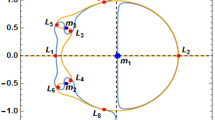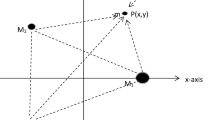Abstract
In this paper, we have studied the existence, locations and stability of the equilibrium points as well as zero velocity curves (ZVCs) under the combined effect of oblateness, radiation pressure and the dissipative force (Stokes drag) in the restricted four-body problem (R4BP) with variable mass when the bigger primary \(m_{1}\) is a source of radiation, second primary \(m_{2}\) is an oblate/prolate spheroid and third primary \(m_{3}\) is a point mass. Jeans’ law and space time transformations of Meshcherskii have been used to derive the equations of motion of the infinitesimal body whose mass is varying. The dynamical behaviour of an infinitesimal body has been investigated under the influence of radiation pressure of bigger primary and oblateness of second primary with Stokes drag. The numerical investigation shows that all the equilibrium points are non-collinear and the collinear equilibrium points do not exist due to the presence of Stokes drag. The effect of oblateness parameter A, radiation parameter \(q\,(0<q<1)\), the proportionality constant \(\alpha \,(0<\alpha \le 2.2)\) occurs in Jeans’ law, parameter due to variation in mass \(\gamma \,(0<\gamma <1)\) and dissipative constant \(k\,(0< k<1)\) have been investigated on the existence, locations of equilibrium points, and their stability. Further, it has been shown that the regions of motion increase for the increasing values of the parameters A, q and \(\alpha\) whereas these regions decrease for the increasing values of the dissipative constant k. We have also explored that all the equilibrium points are unstable for all values of the parameters used.












Similar content being viewed by others
References
Szebehely, V.: Theory of Orbits, the Restricted Problem of Three Bodies. Academic Press, New York (1967)
Sharma, R.K.: The linear stability of libration points of the photogravitational restricted three-body problem when the smaller primary is an oblate spheroid. Astrophys. Space Sci. 135, 271–281 (1987). https://doi.org/10.1007/BF00641562
Suraj, M.S., Mittal, A., Pal, K., Mittal, D.: Stability of the artificial equilibrium points in the low-thrust restricted three-body problem when the smaller primary is an oblate spheroid. Nonlinear Dyn. Syst. Theory. 20(4), 439–450 (2020)
Suraj, M.S., Alhowaity, S., Aggarwal, R., Asique, M.C., Mittal, A., Jain, M.: On the topology of basins of convergence linked to libration points in the modified R3BP with oblateness. New Astron. 94, 101776 (2022). https://doi.org/10.1016/j.newast.2022.101776
Singh, J., Emmanuel, A.B.: Stability of triangular points in the photogravitational CR3BP with Poynting-Robertson drag and a smaller triaxial primary. Astrophys. Space Sci. 353, 97–103 (2014). https://doi.org/10.1007/s10509-014-2023-7
Mittal, A., Iqbal, A., Bhatnagar, K.B.: Periodic orbits generated by Lagrangian solutions of the restricted three-body problem when one of the primaries is an oblate body. Astropys. Space Sci. 319, 63–73 (2008). https://doi.org/10.1007/s10509-008-9942-0
Murray, C.D.: Dynamical effects of drag in the circular restricted three-body problems: I. Location and stability of the Lagrangian equilibrium points. Icarus. 112(2), 465–484 (1994). https://doi.org/10.1006/icar.1994.1198
Baltagiannis, A.N., Papadakis, K.E.: Equilibrium points and their stability in the restricted four-body problem. Int. J. Bifurc. Chaos 21(8), 2179–2193 (2011). https://doi.org/10.1142/S0218127411029707
Arribas, M., Abad, A., Elipe, A., et al.: Equilibria of the symmetric collinear restricted four-body problem with radiation pressure. Astrophys. Space Sci. 361, 84 (2016). https://doi.org/10.1007/s10509-016-2671-x
Zotos, E.E.: Exploring the location and linear stability of the equilibrium points in the equilateral restricted four-body problem. Int. J. Bifurc. Chaos. 30(10), 2050155 (2020). https://doi.org/10.1142/S0218127420501552
Muhammad, S., Duraihem, F.Z., Zotos, E.E.: On the equilibria of the restricted four-body problem with triaxial rigid primaries–I: Oblate bodies. Chaos Solitons Fractals 142, 110500 (2021). https://doi.org/10.1016/j.chaos.2020.110500
Jeans, J.H.: Astronomy and Cosmology. Cambridge University Press, Cambridge (1928)
Meshcherskii, I.V.: Studies on the Mechanics of Bodies of Variable Mass. GITTL, Moscow (1949)
Shrivastava, A.K., Ishwar, B.: Equations of motion of the restricted problem of three bodies with variable mass. Celestial Mech. 30, 323–328 (1983). https://doi.org/10.1007/BF01232197
Lu, T.W.: Analysis on the stability of triangular points in the restricted problem of three-bodies with variable mass. Publ. Purple Mt. Obs. 9(4), 290–296 (1990)
Singh, J., Leke, O.: Stability of the photogravitational restricted three-body problem with variable masses. Astrophys. Space Sci. 326, 305–314 (2010). https://doi.org/10.1007/s10509-009-0253-x
Zhang, M.J., Zhao, C.Y., Xiong, Y.Q.: On the triangular libration points in photogravitational restricted three-body problem with variable mass. Astrophys. Space Sci. 337, 107–113 (2012). https://doi.org/10.1007/s10509-012-1084-8
Abouelmagd, E.I., Mostafa, A.: Out-of-plane equilibrium points locations and the forbidden movement regions in the restricted three-body problem with variable mass. Astrophys. Space Sci. 357, 58 (2015). https://doi.org/10.1007/s10509-015-2294-7
Abouelmagd, E.I., Selim, H.H., Minglibayev, M.Z., Kushekbay, A.K.: A new model emerged from the three-body problem within frame of variable mass. Astron. Rep. 65, 1170–1178 (2021). https://doi.org/10.1134/S1063772921110019
Suraj, M.S., Aggarwal, R., Asique, M.C., Mittal, A.: On the modified circular restricted three-body problem with variable mass. New Astron. 84, 101510 (2021). https://doi.org/10.1016/j.newast.2020.101510
Abouelmagd, E.I.: The effect of photogravitational force and oblateness in the perturbed restricted three-body problem. Astrophys. Space Sci. 346, 51–69 (2013). https://doi.org/10.1007/s10509-013-1439-9
Liou, J.C., Zook, H.A., Jackson, A.A.: Radiation pressure, Poynting-Robertson drag, and solar wind drag in the restricted three-body problem. Icarus. 116, 186–201 (1995)
Ragos, O., Zafiropoulos, F.A., Vrahatis, M.N.: A numerical study of the influence of the Poynting-Robertson effect on the equilibrium points of the photogravitational restricted three-body problem: II. Out of plane case. Astron. Astrophys. 300, 579–590 (1995)
Jain, M., Aggarwal, R.: A study of non-collinear libration points in restricted three-body problem with Stokes drag effect when smaller primary is an oblate spheroid. Astrophys. Space Sci. 358, 51–58 (2015). https://doi.org/10.1007/s10509-015-2457-6
Kumar, D., Jain, M., Aggarwal, R., Satya, S.K.: Stability of \(L_{4,5}\) in the R3BP under the combined effects of Stokes drag and finite straight segment. Int. J. Math. Trends Technol. 45(3), 200–206 (2017). https://doi.org/10.14445/22315373/IJMTT-V45P526
Vincent, A.E., Taura, J.J., Omale, S.O.: Existence and stability of equilibrium points in the photogravitational restricted four-body problem with Stokes drag effect. Astrophys. Space Sci. 20(364), 183 (2019). https://doi.org/10.1007/s10509-019-3674-1
Kushvah, B.S., Sharma, J.P., Ishwar, B.: Nonlinear stability in the generalised photogravitational restricted three-body problem with Poynting-Robertson drag. Astrophys. Space Sci. 312, 279–293 (2007). https://doi.org/10.1007/s10509-007-9688-0
Kumari, R., Kushvah, B.S.: Equilibrium points and zero velocity surfaces in the restricted four-body problem with solar wind drag. Astrophys. Space Sci. 344, 347–359 (2013). https://doi.org/10.1007/s10509-012-1340-y
Singh, J., Omale, S.O.: Combined effect of Stokes drag, oblateness and radiation pressure on the existence and stability of equilibrium points in the restricted four-body problem. Astrophys. Space Sci. 364, 6 (2019). https://doi.org/10.1007/s10509-019-3494-3
Mittal, A., Aggarwal, R., Suraj, M.S., Bisht, V.S.: Stability of libration points in the restricted four-body problem with variable mass. Astrophys. Space Sci. 361, 329 (2016). https://doi.org/10.1007/s10509-016-2901-2
Aggarwal, R., Mittal, A., Suraj, M.S., Bisht, V.S.: The effect of small perturbations in the Coriolis and centrifugal forces on the existence of libration points in the restricted four-body problem with variable mass. Astron. Notes. 339(6), 492–512 (2018). https://doi.org/10.1002/asna.201813411
Suraj, M.S., Mittal, A., Aggarwal, R.: Revealing the existence and stability of equilibrium points in the circular autonomous restricted four-body problem with variable mass. New Astron. 68, 1–9 (2019). https://doi.org/10.1016/j.newast.2018.10.003
Suraj, M.S., Aggarwal, R., Asique, M.C., Mittal, A.: The effect of radiation pressure on the basins of convergence in the restricted four-body problem. Chaos Solitons Fractals 141, 110347 (2020a). https://doi.org/10.1016/j.chaos.2020.110347
Mittal, A., Aggarwal, R., Suraj, M.S., Arora, M.: On the photo-gravitational restricted four-body problem with variable mass. Astrophys. Space Sci. 363, 109 (2018). https://doi.org/10.1007/s10509-018-3321-2
Hadjidemetriou, J.D.: The restricted planetary 4-body problem. Celest. Mech. 21, 63–71 (1980). https://doi.org/10.1007/BF01230248
Malhotra, R.: Orbital resonances in the solar nabula: Strengths and weakness. Icarus. 106, 264–273 (1993). https://doi.org/10.1006/icar.1993.1170
Meshcherskii, I.V.: Work on the Mechanics of Bodies of Variable Mass. GITTL, Moscow (1952)
Murray, C.D., Dermott, S.F.: Solar System Dynamics. Cambridge University Press, Cambridge (1999)
Jain, M., Aggarwal, R.: Existence and stability of non-collinear librations points in the restricted problem with Poynting-Robertson light drag effect. Int. J. Math. Trends Technol. 19, 20–33 (2015)
Jain, M., Aggarwal, R.: Restricted three-body problem with Stokes drag effect. Int. J. Astron. Astrophys. 5, 95–105 (2015)
Mittal, A., Ahmad, I., Bhatnagar, K.B.: Periodic orbits in the photogravitational restricted problem with the smaller primary an oblate body. Astrophys. Space Sci. 323, 65–73 (2009). https://doi.org/10.1007/s10509-009-0038-2
Acknowledgements
The authors are thankful to Center for Fundamental Research in Space dynamics and Celestial mechanics (CFRSC), New Delhi, Delhi, India for providing research facilities.
Funding
This research did not receive any specific grant from any funding agencies.
Author information
Authors and Affiliations
Corresponding author
Ethics declarations
Conflict of interest
The authors declare that they have no conflict of interest.
Additional information
Publisher's Note
Springer Nature remains neutral with regard to jurisdictional claims in published maps and institutional affiliations.
Appendix
Appendix
See Appendix Tables 1, 2, 3, 4, 5, 6, 7, 8, 9.
Rights and permissions
Springer Nature or its licensor (e.g. a society or other partner) holds exclusive rights to this article under a publishing agreement with the author(s) or other rightsholder(s); author self-archiving of the accepted manuscript version of this article is solely governed by the terms of such publishing agreement and applicable law.
About this article
Cite this article
Mittal, A., Pal, K. & Aggarwal, R. The Analysis of the Photogravitational R4BP Under the Combined Effect of Stokes Drag and Oblateness with Variable Mass. J Astronaut Sci 70, 52 (2023). https://doi.org/10.1007/s40295-023-00414-7
Accepted:
Published:
DOI: https://doi.org/10.1007/s40295-023-00414-7




